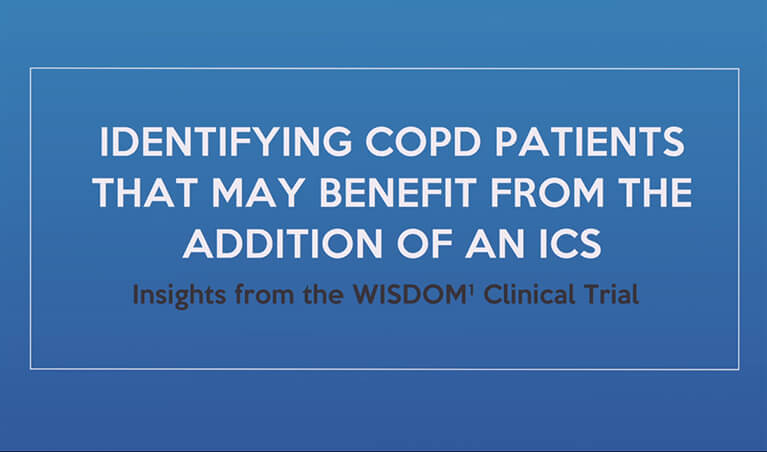More COPD patients than you may realise need1...
inhealability
Some COPD inhalers require more inspiratory
effort than others.1*
SPIOLTO® RESPIMAT® was designed with inhaleability
in mind and to make it easy for your patients to inhale.2
References:
1. Ghosh S et al. Int J Chron Obstruct Pulmon Dis. 2019;14:585-595.
2. Anderson P et al. Int J Chron Pulmon Dis. 2006;1(3):251-259.
ENERGITO4 and FLAME5 demonstrate consistent superiority with LAMA/LABA vs LABA/ICS for all outcomes related to lung function, symptom control and exacerbations
01/03/2019
Author: Boehringer Ingelheim
Optimising therapy and minimising treatment related side effects are important considerations while choosing a treatment option. The ENERGITO study suggests superior lung function improvements with LAMA/LABA vs LABA/ICS and the FLAME study demonstrates significant reduction in the risk of moderate to severe COPD4 exacerbation with LAMA/LABA vs LABA/ICS.
123,000
Views
100k 340
RElated content
What is Spiolto® Respimat® (tiotropium/olodaterol)?
Tiotropium/olodaterol is administered via Respimat®, the only inhaler available that actively delivers a unique mist. This means the patient just needs to take a slow deep breath to get the medication deep into the lungs.*[5-9]
What is the safety profile of Spiolto® Respimat® (tiotropium/olodaterol)?
Adverse event incidence was generally balanced across all treatment groups, with the majority being mild to moderate in severity.[10]
Spiolto® Respimat® safety and tolerability profile was established in patients treated for up to 52 weeks.[10]
The proportion of patients who discontinued due to adverse events with Spiolto® Respimat® was comparable to that of Spiriva® (tiotropium) and Striverdi® (olodaterol).[10]
The percentage of patients reporting an adverse event with Spiolto® Respimat® was comparable to that of Spiriva®.[10]
For full safety profile, please refer to the Local Prescribing Information.
What are the contraindications of Spiolto® Respimat® (tiotropium/olodaterol)?[4]
Spiolto® Respimat® is contraindicated in patients with hypersensitivity to tiotropium or olodaterol or to any of the excipients.
Spiolto® Respimat® is also contraindicated in patients with a history of hypersensitivity to atropine or its derivatives, e.g. ipratropium or oxitropium.
For information on warnings and precautions, please refer to the Local Prescribing Information.
[1] Maltais F et al. Effects of 12 weeks of once-daily tiotropium and olodaterol fixed-dose combination on exercise endurance in patients with COPD. Thorax 2014;69:A186-A187
[2] Ferguson F et al. Efficacy of tiotropium+olodaterol in patients with COPD by initial disease severity and treatment intensity: a post hoc analysis. Adv Ther. 2015; 32(6): 523-526
[3] Singh D et al. Tiotropium+olodaterol shows clinically meaningful improvements in quality of life. Respir Med. 2015; 10: 1312-1319
[4] Spiolto® Respimat® Summary of Product Characteristics, February 2017
[5] Newman SP et al. Lung deposition of fenoterol and flunisolide delivered using a novel device for inhaled medicines: Comparison of Respimat® with conventional metered-dose inhalers with and without spacer devices. Chest 1998; 113: 957-963
[6] Pitcairn G et al. Deposition of corticosteroid aerosol in the human lung by Respimat® Soft Mist™ Inhaler compared to deposition by metered dose inhaler or by Turbuhaler® dry powder inhaler. J Aerosol Med 2005; 18(3): 264-272
[7] Dalby R et al. A review of the development of Respimat® Soft Mist™ Inhaler. Int J Pharm 2004; 283: 1-9
[8] Dalby RN et al. Development of Respimat® SoftMist™ inhaler and its clinical utility in respiratory disorders. Med Devices (Auckl) 2011; 4: 145-155
[9] Anderson P. Use of Respimat Soft Mist Inhaler in COPD patients. Int J Chron Obstruct Pulmon Dis 2006; 1(3): 251–259
[10] Buhl R, et al. Eur Respir J. 2015;45:969-979.
[11] Spiriva® Respimat® Summary of Product Characteristics January 2017.
[12] Striverdi® Respimat® Summary of Product Characteristics March 2016.
References
1. Pitcairn G et al. J Aerosol Med 2005;3:264-272.
2. Anderson A. Int J Chron Obstruct Pulmon Dis 2006;1:251-259.
3. Dalby R et al. Med Devices: Evidence and Research 2011;4:145-155.
4. Beeh KM et al. Int J Chron Obstruct Pulmon Dis 2016;11:193-205.
5. Wedzicha JA et al. N Engl J Med 2016;374(23):2222-2234.
Production date: Mar 2019


